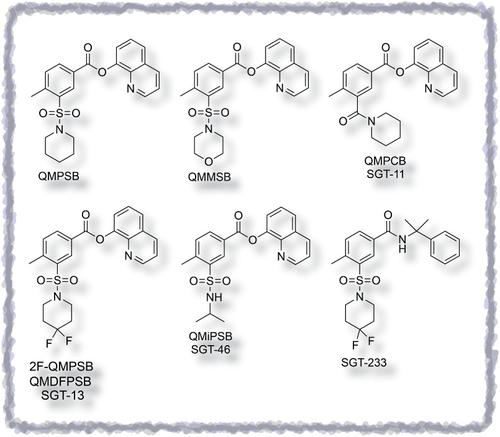当前位置:
X-MOL 学术
›
Drug Test. Anal.
›
论文详情
Our official English website, www.x-mol.net, welcomes your
feedback! (Note: you will need to create a separate account there.)
Synthetic cannabinoid receptor agonists: analytical profiles and development of QMPSB, QMMSB, QMPCB, 2F-QMPSB, QMiPSB, and SGT-233.
Drug Testing and Analysis ( IF 2.6 ) Pub Date : 2020-08-16 , DOI: 10.1002/dta.2913 Simon D Brandt 1 , Pierce V Kavanagh 2 , Folker Westphal 3 , Wolfgang Dreiseitel 4 , Geraldine Dowling 2, 5 , Matthew J Bowden 6 , James P B Williamson 7
Drug Testing and Analysis ( IF 2.6 ) Pub Date : 2020-08-16 , DOI: 10.1002/dta.2913 Simon D Brandt 1 , Pierce V Kavanagh 2 , Folker Westphal 3 , Wolfgang Dreiseitel 4 , Geraldine Dowling 2, 5 , Matthew J Bowden 6 , James P B Williamson 7
Affiliation

|
A diverse assortment of molecules designed to explore the cannabinoid receptor system and considered new psychoactive substances (NPS) have become known as synthetic cannabinoid receptor agonists (SCRAs). One group of SCRAs that has received little attention involves those exhibiting sulfamoyl benzoate, sulfamoyl benzamide, and N‐benzoylpiperidine based structures. In this study, quinolin‐8‐yl 4‐methyl‐3‐(piperidine‐1‐sulfonyl)benzoate (QMPSB), quinolin‐8‐yl 4‐methyl‐3‐(morpholine‐4‐sulfonyl)benzoate (QMMSB), quinolin‐8‐yl 4‐methyl‐3‐(piperidine‐1‐carbonyl)benzoate (QMPCB, SGT‐11), quinolin‐8‐yl 3‐(4,4‐difluoropiperidine‐1‐sulfonyl)‐4‐methylbenzoate (2F‐QMPSB, QMDFPSB, SGT‐13), quinolin‐8‐yl 4‐methyl‐3‐[(propan‐2‐yl)sulfamoyl]benzoate (QMiPSB, SGT‐46), and 3‐(4,4‐difluoropiperidine‐1‐sulfonyl)‐4‐methyl‐N‐(2‐phenylpropan‐2‐yl)benzamide (SGT‐233) were extensively characterized (including data on impurities). The analytical profiles may be useful to researchers and scientists who deal with the emergence of NPS during forensic and clinical investigations. The detection of QMPSB was first published in 2016 but it is worth noting that Stargate International, a company originally formed to develop harm reduction solutions, were involved in the investigation and development of these six compounds for potential release between 2011 and early 2014. Whilst information on the prevalence of use of these particular compounds at the present time is limited, one of the key outcomes of the research performed by Stargate International reviewed here was to set the stage for the quinolin‐8‐yl ester head group that ultimately led to hybridization with an N‐alkyl‐1H‐indole core to give SGT‐21 and SGT‐32, which became later known as PB‐22 (QMPSB/JWH‐018 hybrid) and BB‐22, respectively, thus, opening the door to a range of SCRAs carrying the quinolin‐8‐yl head group from about 2012 onwards.
中文翻译:

合成大麻素受体激动剂:QMPSB、QMMSB、QMPCB、2F-QMPSB、QMiPSB 和 SGT-233 的分析概况和开发。
旨在探索大麻素受体系统和被认为是新的精神活性物质 (NPS) 的各种分子已被称为合成大麻素受体激动剂 (SCRAs)。一组很少受到关注的 SCRA 涉及那些表现出氨磺酰苯甲酸酯、氨磺酰苯甲酰胺和N-苯甲酰哌啶结构的 SCRAs 。在本研究中,喹啉-8-基4-甲基-3-(哌啶-1-磺酰基)苯甲酸酯(QMPSB)、喹啉-8-基4-甲基-3-(吗啉-4-磺酰基)苯甲酸酯(QMMSB),喹啉-8-基4-甲基-3-(哌啶-1-羰基)苯甲酸酯(QMPCB,SGT-11),喹啉-8-基3-(4,4-二氟哌啶-1-磺酰基)-4-甲基苯甲酸酯( 2F-QMPSB、QMDFPSB、SGT-13)、喹啉-8-基4-甲基-3-[(丙-2-基)氨磺酰基]苯甲酸酯(QMiPSB、SGT-46)和3-(4,4-二氟哌啶) -1-磺酰基)-4-甲基-N-(2-苯基丙-2-基)苯甲酰胺(SGT-233)被广泛表征(包括杂质数据)。分析概况可能对在法医和临床调查期间处理 NPS 出现的研究人员和科学家有用。QMPSB 的检测首次发布于 2016 年,但值得注意的是,最初成立以开发减害解决方案的公司 Stargate International 参与了这六种化合物的调查和开发,以在 2011 年至 2014 年初之间可能释放。虽然信息由于目前使用这些特定化合物的流行程度有限,此处审查的 Stargate International 进行的研究的主要成果之一是为最终导致杂交的喹啉-8-基酯头部基团奠定了基础带着N-烷基-1 H-吲哚核得到 SGT-21 和 SGT-32,后来分别称为 PB-22(QMPSB/JWH-018 混合)和 BB-22,从而打开了一个范围的大门大约从 2012 年开始,携带喹啉-8-基头基的 SCRAs。
更新日期:2020-08-16
中文翻译:

合成大麻素受体激动剂:QMPSB、QMMSB、QMPCB、2F-QMPSB、QMiPSB 和 SGT-233 的分析概况和开发。
旨在探索大麻素受体系统和被认为是新的精神活性物质 (NPS) 的各种分子已被称为合成大麻素受体激动剂 (SCRAs)。一组很少受到关注的 SCRA 涉及那些表现出氨磺酰苯甲酸酯、氨磺酰苯甲酰胺和N-苯甲酰哌啶结构的 SCRAs 。在本研究中,喹啉-8-基4-甲基-3-(哌啶-1-磺酰基)苯甲酸酯(QMPSB)、喹啉-8-基4-甲基-3-(吗啉-4-磺酰基)苯甲酸酯(QMMSB),喹啉-8-基4-甲基-3-(哌啶-1-羰基)苯甲酸酯(QMPCB,SGT-11),喹啉-8-基3-(4,4-二氟哌啶-1-磺酰基)-4-甲基苯甲酸酯( 2F-QMPSB、QMDFPSB、SGT-13)、喹啉-8-基4-甲基-3-[(丙-2-基)氨磺酰基]苯甲酸酯(QMiPSB、SGT-46)和3-(4,4-二氟哌啶) -1-磺酰基)-4-甲基-N-(2-苯基丙-2-基)苯甲酰胺(SGT-233)被广泛表征(包括杂质数据)。分析概况可能对在法医和临床调查期间处理 NPS 出现的研究人员和科学家有用。QMPSB 的检测首次发布于 2016 年,但值得注意的是,最初成立以开发减害解决方案的公司 Stargate International 参与了这六种化合物的调查和开发,以在 2011 年至 2014 年初之间可能释放。虽然信息由于目前使用这些特定化合物的流行程度有限,此处审查的 Stargate International 进行的研究的主要成果之一是为最终导致杂交的喹啉-8-基酯头部基团奠定了基础带着N-烷基-1 H-吲哚核得到 SGT-21 和 SGT-32,后来分别称为 PB-22(QMPSB/JWH-018 混合)和 BB-22,从而打开了一个范围的大门大约从 2012 年开始,携带喹啉-8-基头基的 SCRAs。






























 京公网安备 11010802027423号
京公网安备 11010802027423号